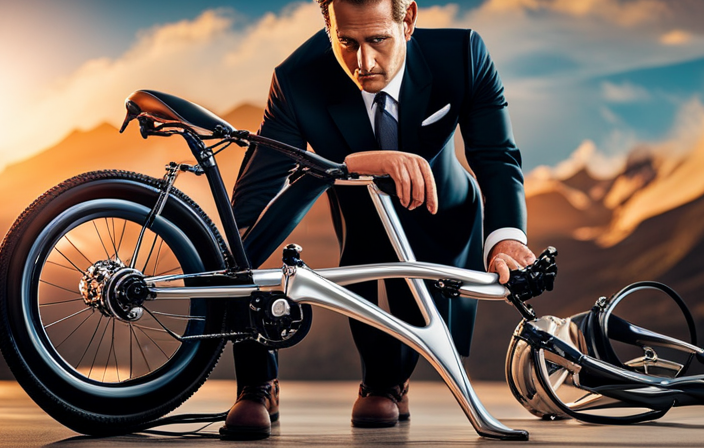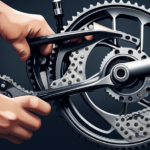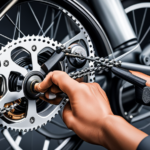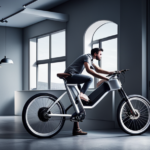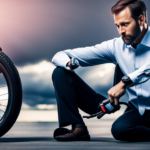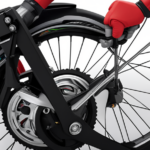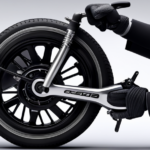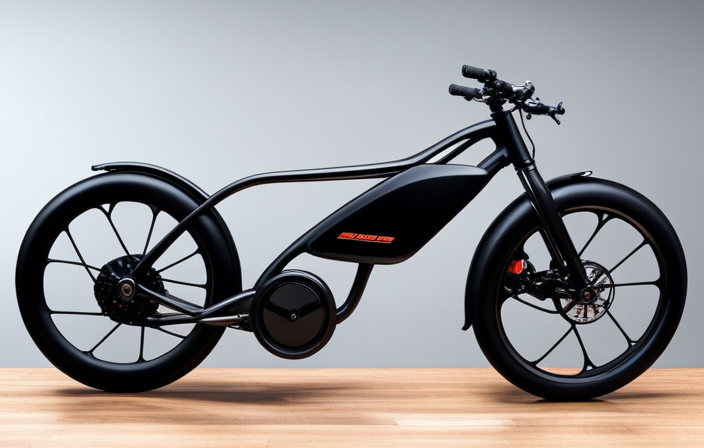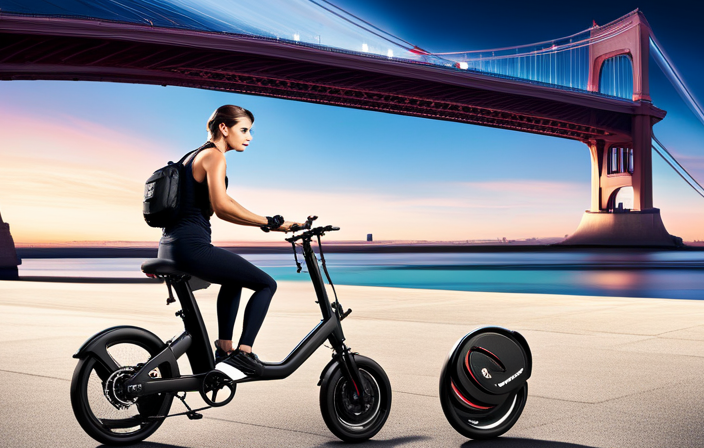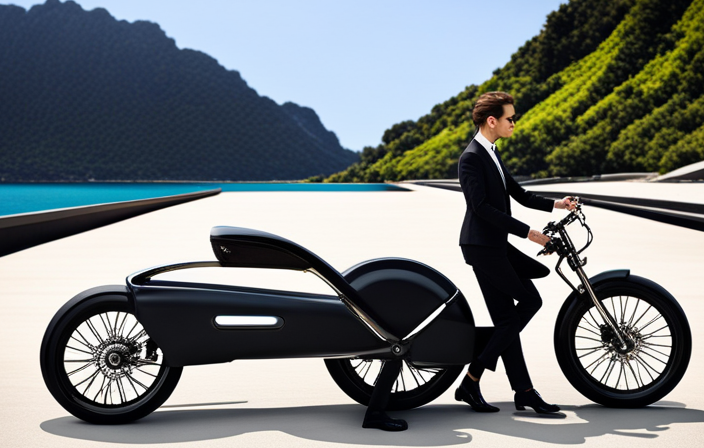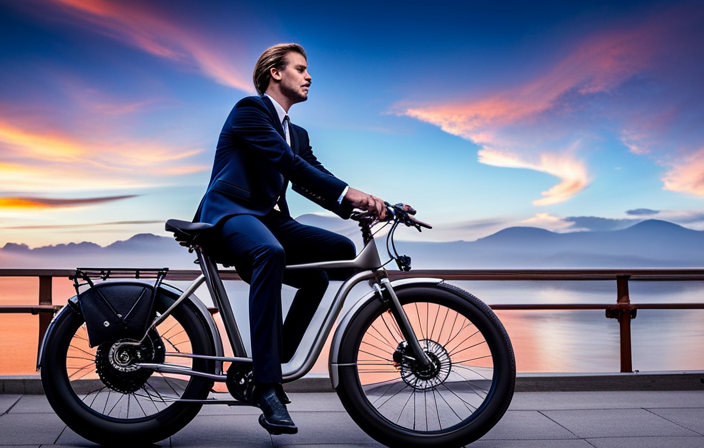Imagine riding your Sunseeker electric bike on a sunny day, feeling the wind in your hair and the thrill of the open road.
But suddenly, you notice that something feels off. Your bike is veering to one side, and you’re struggling to maintain control.
Don’t worry, because in this article, I will guide you step-by-step on how to align your Sunseeker electric bike. By following these detailed instructions and using the right tools, you’ll be back on track and enjoying a smooth and balanced ride in no time.
Key Takeaways
- Regularly inspect and visually align the chain with the rear sprocket
- Troubleshoot and address misalignment issues such as a misaligned rear wheel or bent derailleur hanger
- Ensure proper alignment for improved handling, increased efficiency, and reduced risk of injury
- Seek professional help for precise alignment adjustments and maintenance to enjoy a smoother ride and optimal performance.
Understanding the Importance of Bike Alignment
You need to understand the importance of bike alignment. Proper alignment is crucial for a Sunseeker electric bike as it ensures optimal performance and longevity.
When the bike is aligned correctly, it allows for better handling and control, reducing the risk of accidents.
One of the key benefits of bike alignment is improved efficiency. When the wheels are aligned properly, there is less friction, resulting in smoother rides and increased speed.
Additionally, proper alignment helps prevent premature wear and tear on the tires and other components, saving you money on replacements. It also contributes to a more comfortable riding experience by reducing vibrations and unnecessary strain on your body.
Overall, investing time in aligning your Sunseeker electric bike is essential for maximizing its performance and enjoying a safer and more enjoyable ride.
Gathering the Necessary Tools
To prepare for aligning the components of the Sunseeker electric bike, gather the required tools. Here is a list of essential tools you will need:
-
Bike stand: Selecting the right bike stand is crucial for proper alignment. Look for a sturdy stand that can securely hold the weight of the electric bike.
-
Torque wrench: Using a torque wrench is essential to ensure proper alignment of the bike’s components. This tool allows you to apply the correct amount of torque to the bolts, preventing under or over tightening.
-
Allen wrench set: An Allen wrench set is necessary to loosen and tighten bolts on the bike. Make sure to have a variety of sizes to accommodate different components.
By having these tools ready, you will be well-prepared to align your Sunseeker electric bike accurately. Remember to follow the manufacturer’s instructions and take your time to ensure proper alignment for optimal performance.
Preparing Your Sunseeker Electric Bike for Alignment
Get your Sunseeker electric bike ready for alignment by taking the necessary steps to prepare it. Before beginning the alignment process, it is important to address any common alignment issues that may be affecting your bike’s performance. These issues can include misaligned wheels, uneven tire wear, or a crooked handlebar. To troubleshoot these alignment problems, start by checking the wheel alignment using a straight edge or string. Adjust the wheel alignment by loosening the axle nuts and aligning the wheel with the frame. Additionally, inspect the tire wear patterns for any signs of uneven wear, which could indicate alignment issues. Finally, ensure that the handlebar is straight by loosening the stem bolts and adjusting it accordingly. By addressing these common alignment issues, you can ensure that your Sunseeker electric bike is ready for alignment.
Adjusting the Handlebars
Make sure the handlebars on your Sunseeker e-bike are properly adjusted for a comfortable and ergonomic riding position. Adjusting the handlebars is crucial to prevent strain on your wrists, arms, and back while riding. To ensure the best fit, follow these steps:
- Start by loosening the handlebar clamp bolts using an Allen wrench.
- Adjust the handlebars to your desired height and angle.
- Tighten the clamp bolts securely, ensuring the handlebars are stable.
Adjusting the seat height is another important aspect of bike alignment. A properly adjusted seat height can improve pedaling efficiency and prevent knee pain. To adjust the seat height, loosen the seat clamp bolt, raise or lower the seat to your desired height, and then tighten the bolt securely.
If you encounter common alignment issues like the bike pulling to one side or feeling unstable, check the wheel alignment and tire pressure. Ensure the wheels are straight and aligned with the handlebars. Also, make sure the tires are properly inflated to the recommended pressure. If problems persist, consult the user manual or contact a professional for further assistance.
Aligning the Front Wheel
Ensure that the front wheel of your e-bike is properly aligned for a smooth and stable ride. Front wheel alignment is crucial to maintain control and prevent unnecessary wear on the tires.
To align the front wheel, start by loosening the axle nuts on both sides of the wheel. Next, hold the handlebars straight and tighten the nuts evenly until they are snug. Make sure the wheel is centered between the fork legs and spins freely without any wobbling.
If you experience any alignment issues, check for loose or damaged spokes, bent forks, or misaligned axle. Adjust or replace any faulty components as necessary.
Remember, a properly aligned front wheel ensures a safe and enjoyable riding experience.
Checking the Frame Alignment
Check the frame alignment of your e-bike to ensure a stable and smooth ride.
When checking the frame alignment, it’s important to start by visually inspecting the bike from a distance, looking for any obvious signs of misalignment such as crooked handlebars or an uneven seat.
Next, you can use a straight edge, like a ruler or a level, to check if the frame is straight by placing it against the top tube, down tube, and seat tube. If the straight edge doesn’t lay flat against all three tubes, it may indicate a misalignment.
Additionally, you can check the alignment of the rear wheel by measuring the distance between the chainstays and the rim on both sides.
Troubleshooting alignment issues may involve adjusting the frame or seeking professional assistance to ensure proper alignment for optimal performance and safety.
Aligning the Rear Wheel
To properly align the rear wheel, start by measuring the distance between the chainstays and the rim on both sides. This will ensure that the wheel is centered and aligned correctly. If there is an imbalance in the measurements, you may need to make adjustments to achieve proper alignment.
Here are some troubleshooting tips for rear wheel alignment:
- Loosen the axle nuts or quick-release skewer and gently tap the wheel to center it.
- Check for any loose or damaged spokes and tighten or replace them as necessary.
- Inspect the dropout alignment and make sure it is straight and parallel to the frame.
- Use a wheel alignment tool or a string to check the alignment from the rear to the front wheel.
- If all else fails, consult a professional bike mechanic for further assistance.
By following these steps, you can troubleshoot and resolve any rear wheel alignment issues on your Sunseeker electric bike.
Ensuring Proper Chain Alignment
Make sure your chain is properly aligned with the rear wheel for optimal performance.
Proper chain tension is crucial to ensure smooth and efficient pedaling on your Sunseeker electric bike.
To troubleshoot alignment issues, start by checking the chain tension.
It should have a slight amount of play, about 1/2 inch up and down when pushed at the midpoint between the front and rear sprockets.
If the tension is too loose, adjust it by tightening the rear axle nuts or using the chain tensioner if your bike is equipped with one.
If the chain is too tight, loosen the rear axle nuts or use the chain tensioner to increase the play.
Additionally, inspect the rear sprocket alignment with the front chainring.
They should be perfectly aligned for optimal chain performance.
Proper chain alignment is essential for a smooth and efficient ride on your Sunseeker electric bike.
Testing and Fine-Tuning the Alignment
You can ensure optimal performance by testing and fine-tuning the alignment of your chain on the rear wheel.
When it comes to testing the alignment, there are a few techniques you can use. One method is to visually inspect the alignment of the chain with the rear sprocket. Make sure the chain is running straight and centered on the sprocket teeth.
Another technique is to spin the rear wheel while observing the movement of the chain. It should move smoothly and without any noticeable wobbling or jumping.
If you encounter any alignment issues, troubleshooting is necessary. Common alignment issues include a misaligned rear wheel or a bent derailleur hanger.
To fix a misaligned rear wheel, you can loosen the axle nuts and adjust the position of the wheel until the chain runs straight. If the derailleur hanger is bent, it may need to be replaced or straightened using a derailleur hanger alignment tool.
By testing and troubleshooting any alignment issues, you can ensure that your Sunseeker electric bike performs at its best.
Maintaining Regular Bike Alignment for Optimal Performance
Ensure that your regular bike alignment is maintained for optimal performance. Proper bike alignment offers numerous benefits, including improved handling, increased efficiency, and reduced risk of injury. To maintain your bike’s alignment, follow these essential tips:
-
Regular Inspections: Check your bike’s alignment regularly, especially after any impacts or crashes. Look for misalignments in the frame, fork, and wheels.
-
Adjustments: If you notice any misalignments, make the necessary adjustments. This may involve realigning the handlebars, adjusting the saddle position, or aligning the wheel axles.
-
Professional Help: If you’re unsure how to perform alignment adjustments, seek assistance from a professional bike mechanic. They have the expertise and tools to ensure precise alignment.
Regular bike alignment maintenance is crucial for optimal performance and safety. By following these tips, you can enjoy a smoother ride and prolong the lifespan of your Sunseeker electric bike.
Frequently Asked Questions
How often should I align my sunseeker electric bike?
Aligning a Sunseeker electric bike should be done every 6-12 months. It typically takes about 15-30 minutes to complete. Regular alignment ensures optimal performance, improves handling, reduces wear on components, and enhances overall riding experience.
Can I align my bike without any specialized tools?
Aligning a bike without specialized tools is possible but challenging. However, it’s best to use proper alignment techniques to avoid common alignment issues. With patience and attention to detail, you can ensure your Sunseeker electric bike stays in optimal condition.
What are the signs that my bike is misaligned?
Signs of a misaligned bike include uneven tire wear, difficulty in steering, and a bike that pulls to one side. To properly align the bike, adjust the handlebars, seat, and wheels until they are all aligned correctly.
Is it possible to align the bike on my own or should I take it to a professional?
Aligning a bike on your own can be a frustrating experience, trust me! The benefits of professional alignment are numerous. They have the expertise, proper tools, and knowledge of aligning techniques to ensure optimal performance.
Are there any specific safety precautions I should take while aligning my sunseeker electric bike?
When aligning my Sunseeker electric bike, it is important to follow specific safety measures. To ensure a successful alignment, I will carefully follow the step-by-step alignment process, taking necessary precautions to avoid any accidents or injuries.
Conclusion
In conclusion, aligning your Sunseeker Electric Bike is crucial for optimal performance and safety.
By following the steps outlined in this article, you can ensure that your bike’s handlebars, front and rear wheels, and chain are all properly aligned.
One interesting statistic to note is that a misaligned bike can reduce efficiency by up to 4%, resulting in increased energy expenditure and decreased speed.
Therefore, regularly maintaining bike alignment is essential for a smooth and enjoyable riding experience.

